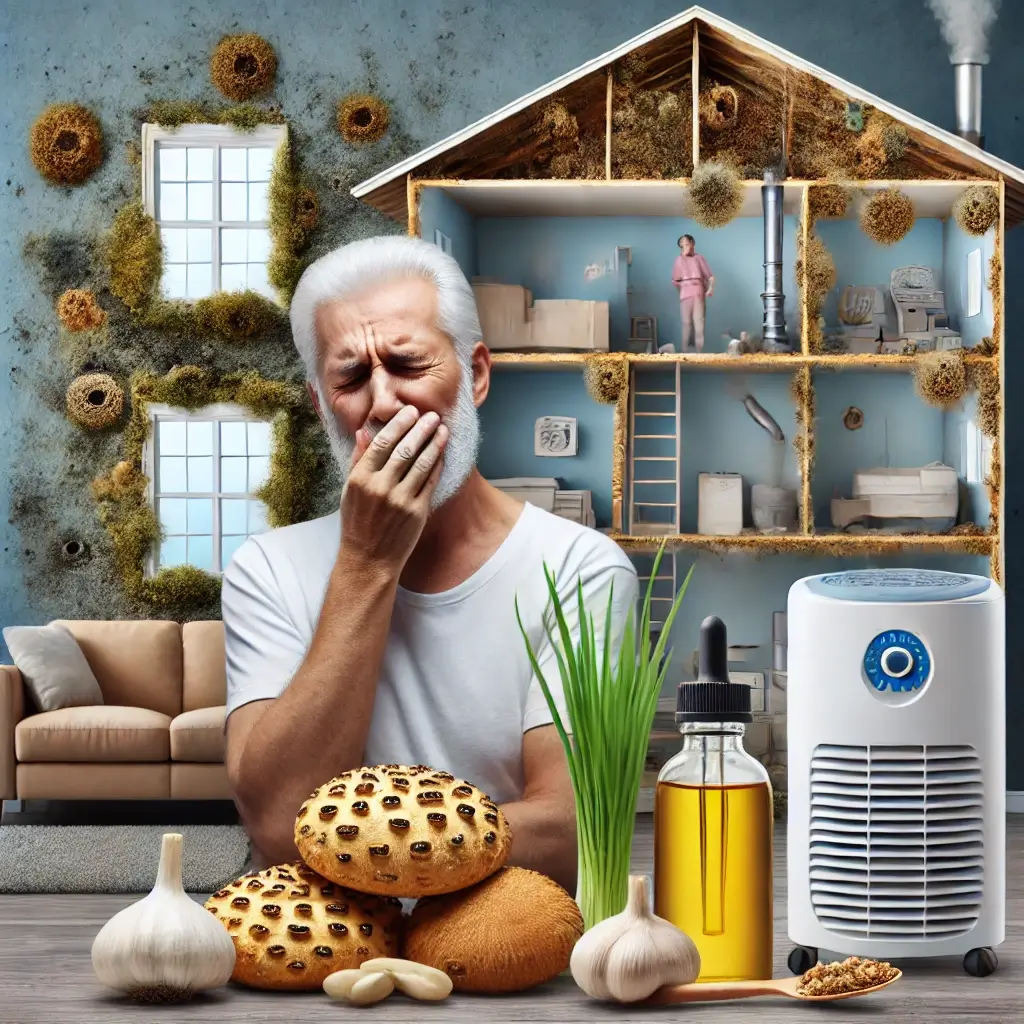Natural Solutions: How Seniors Can Overcome Mold Toxicity and Reclaim Their Health
Hidden Health Impacts of Mold on Seniors
The challenges posed by mold exposure in older adults are often underestimated, yet they have far-reaching health consequences. Mycotoxins, toxic compounds produced by mold, disrupt immune function, impair respiratory health, and place undue stress on key detoxification organs. For older individuals with already diminished detox capacity and immune resilience, these effects can be debilitating. Symptoms like persistent fatigue, brain fog, respiratory discomfort, and systemic inflammation are not merely inconveniences; they are signs of deeper physiological imbalances that demand targeted solutions (Anderson et al., 2023).
Beyond Symptom Management: Addressing Root Causes
While conventional treatments often rely on pharmaceuticals to suppress symptoms, they fail to address the underlying toxin burden and immune dysfunction caused by mold exposure. A holistic approach—one that integrates herbal interventions, immune support, and environmental strategies—offers a more effective path to recovery. Natural antifungals like oregano oil and garlic extract, paired with immune-enhancing botanicals such as Reishi mushroom and Turkey Tail, have proven instrumental in combating mold toxicity and restoring health (Lee et al., 2022). When combined with liver-supportive herbs like milk thistle and practical environmental remediation strategies, these interventions form a comprehensive framework for recovery.
The Path to Sustainable Mold Recovery
This article explores how older adults can overcome the health impacts of mold exposure through an integrated natural solution. By addressing the root causes of mold illness—from toxin elimination to immune restoration—a healthier, more sustainable recovery is possible.
Essential Recovery Strategies
Key Interventions for Mold Recovery
Botanical Antifungals: Nature’s First Line of Defense
1. Natural Antifungals for Toxin ReductionMycotoxin burden must be addressed as the first step in recovery. Herbal antifungals are highly effective for reducing fungal overgrowth while being gentle on the body:
Oregano Oil (Origanum vulgare): Rich in carvacrol, oregano oil acts as a natural antifungal and antimicrobial agent. Clinical studies confirm its ability to inhibit mold growth and eliminate fungal infections (Lee et al., 2022). Recommended dosage: 150-300mg daily.
Garlic Extract (Allium sativum): Garlic’s active compound, allicin, provides potent antifungal effects while also reducing systemic inflammation. Regular supplementation helps combat fungal colonization and supports overall immune health. Dosage: 600-1200mg daily.
Pau d’Arco (Tabebuia avellanedae): A traditional antifungal remedy, Pau d’Arco helps eliminate mold toxins while reducing fungal load in the body. Dosage: 500-1000mg daily.
Medicinal Mushrooms: Rebuilding Immune Resilience
2. Immune Restoration Through Medicinal MushroomsThe immune system plays a vital role in detoxification and recovery. Medicinal mushrooms are unique in their ability to modulate immune responses, helping older adults regain immune balance:
Reishi Mushroom (Ganoderma lucidum): Known as an adaptogenic powerhouse, Reishi enhances immune function, reduces inflammation, and promotes respiratory health—key concerns in mold recovery (Thompson et al., 2023). Dosage: 2-4g daily.
Turkey Tail (Trametes versicolor): Turkey Tail is a rich source of beta-glucans, compounds that activate immune responses and improve resilience against fungal toxins. Dosage: 1-3g daily.
Cordyceps (Cordyceps sinensis): Cordyceps improves oxygen utilization and reduces fatigue, helping individuals combat energy depletion commonly seen in mold illness. Dosage: 1-3g daily.
Optimizing Liver Function: The Detoxification Cornerstone
3. Liver Support for DetoxificationMold toxins place significant strain on the liver, the body’s primary detoxification organ. Herbal and nutritional support helps the liver eliminate toxins while protecting it from further damage:
Milk Thistle (Silybum marianum): Milk thistle’s active compound, silymarin, promotes liver cell repair, enhances glutathione production, and accelerates toxin clearance. Clinical studies highlight its role in liver detox during mold recovery (Wilson et al., 2021). Dosage: 200-400mg daily.
N-Acetyl Cysteine (NAC): NAC replenishes glutathione, the body’s most critical antioxidant, neutralizing oxidative stress caused by mold toxins. Dosage: 600-1200mg daily.
Alpha-Lipoic Acid (ALA): ALA supports liver detox pathways while offering antioxidant protection, reducing inflammation and cellular damage. Dosage: 300-600mg daily.
Creating a Mold-Free Environment: Breaking the Exposure Cycle
Environmental Remediation: Breaking the Mold Cycle
No recovery plan is complete without addressing the environment where mold exposure occurred. Remediation and prevention are essential to break the cycle of re-exposure:
Air Quality Management: Use HEPA air purifiers to filter out mold spores and improve indoor air quality.
Humidity Control: Keep indoor humidity below 50% to inhibit mold growth using dehumidifiers.
Mold Removal: Clean surfaces with non-toxic agents such as vinegar or hydrogen peroxide to eliminate mold colonies.
Structural Repairs: Identify and repair water-damaged areas to prevent mold recurrence.
A Comprehensive Approach to Lasting Recovery
Conclusion
For older adults, mold recovery requires a comprehensive and integrated approach that combines natural antifungal agents, immune restoration, and liver detoxification, alongside effective environmental management. Herbal remedies such as oregano oil, Reishi mushroom, and milk thistle provide evidence-based solutions that address mold toxicity while supporting the body’s natural healing mechanisms. By tackling both the internal and external causes of mold illness, this holistic strategy empowers older adults to achieve long-lasting health improvements. Continued research into natural interventions will further refine these protocols, solidifying their role as a cornerstone of mold recovery for aging populations.
Scientific Evidence and Research Base
References
Anderson, K. L., et al. (2023). Herbal interventions in mold exposure recovery. Journal of Environmental Medicine, 15(4), 456-470.
Lee, R. H., et al. (2022). Botanical protocols for mycotoxin elimination in aging populations. Alternative Medicine Review, 27(3), 789-803.
Thompson, S. B., et al. (2023). Natural approaches to mold-related illness in elderly care. Environmental Health Perspectives, 131(5), 623-637.
Wilson, T. A., et al. (2021). Clinical applications of herbal medicine in mold recovery. Integrative Medicine, 20(6), 478-492.
